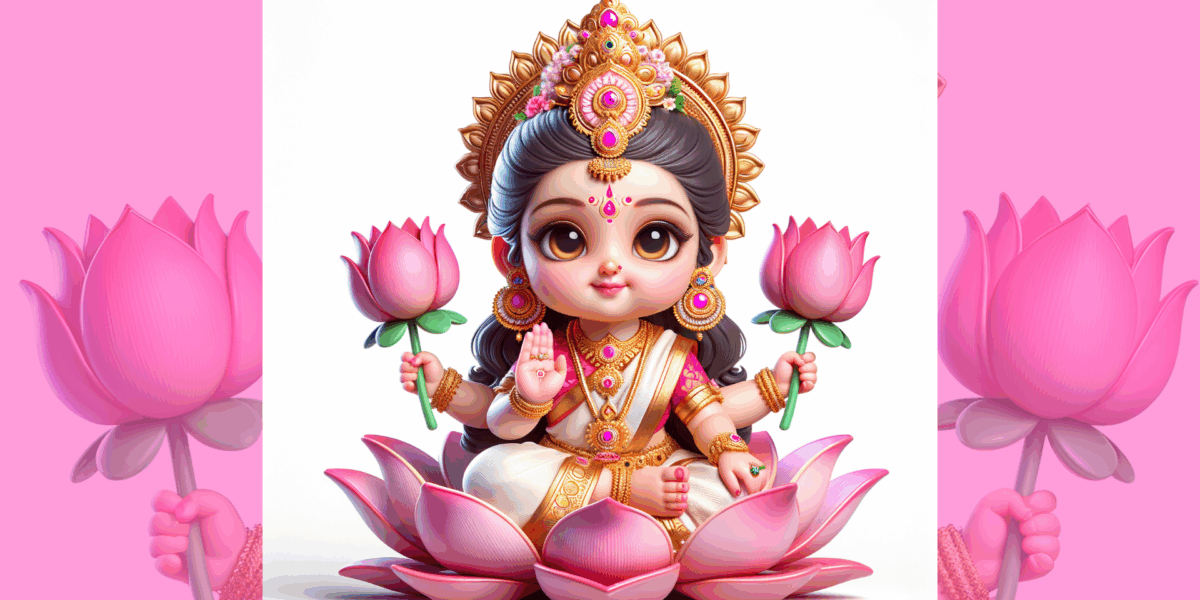Hiraṇyavarṇāṁ hariṇīṁ suvarṇa-rajata-srajām |
candrāṁ hiraṇmayīṁ Lakṣmīṁ jāta-vedo ma āvaha ||
– Śrī Sūktam
We all know that Maa Lakshmi is the Goddess of Wealth. We get a Lakshmi Ganesha every Diwali and do intense prayers for good luck.
Still, many people say that their wishes are not being heard. What could be the missing link?
The point is that wealth is not the only form of Abundance. Imagine when you were planning your first child, would you have traded that with a couple of lacs? Or if your deepest desire was to top a class or for your child to clear a competitive exam, could money replace that? No.
The truth is that Abundance comes in different forms, and we need each one of them to feel truly happy.
Enter the Ashta Lakshmis – the seven forms of Maa Lakshmi.
Let us learn about them in detail.
1. Ādi Lakshmi: The Primordial Grace
Ādi Lakshmi represents the original, ever-present blessing that steadies life. She is the calm foundation on which all other forms of prosperity stand, inviting inner balance, faith, and right direction.
- Iconography: Seated on a lotus, serene, holding a lotus and rosary with blessing (varada) and protection (abhaya) mudras.
- Devotees seek: Inner stability, a clear heart, and the strength to walk a dharmic path—so every other blessing can take root.
2. Dhana Lakshmi: The Bestower of Wealth
Dhana Lakshmi signifies material prosperity—income, assets, and the resources needed to build and serve. She teaches that wealth must be pure, earned with integrity, and used wisely.
- Iconography: Radiant, seated or standing on a lotus, coins flowing from a full pot (kalaśa), hands in blessing.
- Devotees seek: Steady earnings, flourishing work, and wisdom to manage wealth for family welfare and charity.
3. Dhānya Lakshmi: The Bestower of Grains
Dhānya Lakshmi embodies nourishment and food security—the life-force that keeps homes and societies strong. True prosperity begins with wholesome food and the grace to share it.
- Iconography: Golden hue, holding a sheaf of grain and a pot of cereals; sometimes with cow and calf or overflowing granaries.
- Devotees seek: Timely rains, good harvests, a well-stocked kitchen, robust health, and the virtue of annadāna (sharing food).
4. Gaja Lakshmi: The Queenly Protector
Gaja Lakshmi stands for royal abundance, honor, and protection; she restores dignity after struggle and safeguards rightful prosperity.
- Iconography: Two elephants perform abhiṣeka (ritual bathing) as she sits on a lotus; flowing water marks auspicious fame and strength.
- Devotees seek: Reputation, lawful protection, stability in leadership, and grace under pressure.
5. Santāna Lakshmi: The Blessing of Continuity
Santāna Lakshmi represents continuity—children, lineage, students, and all who carry our work forward. She nurtures healthy growth in family and community.
- Iconography: Motherly form with a child on her lap; often a water pot and lotus signifying nourishment and purity.
- Devotees seek: Safe motherhood, children’s well-being, strong family bonds, and guidance to raise the next generation with values.
6. Vīra (Dhairya) Lakshmi: The Courage to Persevere
Vīra/Dhairya Lakshmi is bravery and endurance—the inner strength to act at the right time and persist without drama.
- Iconography: Emblems of strength (sword/shield) alongside lotus and blessing gestures, affirming fearless yet compassionate action.
- Devotees seek: Courage in decisions, patience in long efforts, and resilience when life tests one’s resolve.
7. Vijaya (Jaya) Lakshmi: The Grace of Victory
Vijaya/Jaya Lakshmi represents successful outcomes earned through right effort—the auspicious completion of endeavors.
- Iconography: Conch, discus, or a victory banner with the lotus; a calm, sattvic radiance of triumph.
- Devotees seek: Blessings for exams, legal matters, projects, competitions—any undertaking where clean, timely victory is desired.
8. Vidyā Lakshmi: The Light of Knowledge
Vidyā Lakshmi bestows sacred knowledge, learning, and discernment, aligning intellect with humility so prosperity remains beneficial.
- Iconography: Seated on a lotus with a book and rosary; calm, contemplative expression of study and insight.
- Devotees seek: Focus in education, clarity in judgment, sharp memory, and the wisdom to use skills for the good of all.
How to connect to AshtaLakshmi?
Simple acts are more powerful than rituals- especially if you haven’t yet learned how to worship them.
- Donate food every Friday- white rice, batasha, white rice kheer
- Light a diya every evening in your temple and outside your home. Ghee works best, add a pinch of turmeric in it.
- Do the Sri Suktam daily or at least every Friday after bath.
- Be abundant in your heart – do not negotiate, be kind to poor vendors.
Lakshmi is an energy- not a ritual. Be aware- if you were Lakshmi, what would your behavior be like?
Hope this blog helps you to connect to the abundance within you.
God bless.

Dr. Manmeet Kumar is a Spiritual Coach who founded Soul Miracles in 2016. She uses her gifts of being a psychic and a medium to enable others to transform their inner core.

